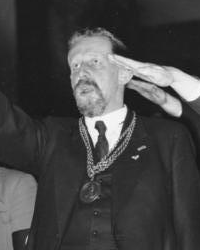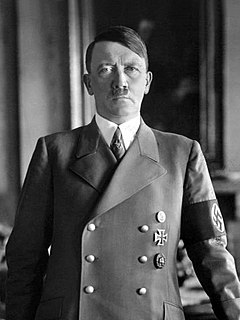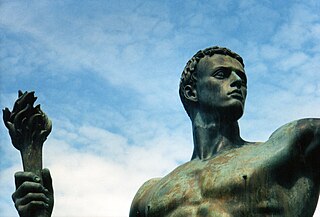 W
WNazi eugenics, refers to the social policies of eugenics in Nazi Germany. The racial ideology of Nazism placed the biological improvement of the German people by selective breeding of "Nordic" or "Aryan" traits at its center.
 W
WAction 14f13, also called "Sonderbehandlung 14f13" and Aktion 14f13, was a campaign by Nazi Germany to terminate Nazi concentration camp prisoners. Also called invalid or prisoner euthanasia, the campaign culled the sick, elderly and those deemed no longer fit for work, from the rest of the prisoners in a selection process, after which they were killed. The Nazi campaign was in operation from 1941 to 1944 and later covered other groups of concentration camp prisoners.
 W
WThe Ahnenpaß documented the Aryan lineage of people "of German blood" in Nazi Germany. It was one of the forms of the Aryan certificate (Ariernachweis) and issued by the "Reich Association of Marriage Registrars in Germany".
 W
WAktion T4 was a campaign of mass murder by involuntary euthanasia in Nazi Germany. The term was first used in post-war trials against doctors who had been involved in the killings. The name T4 is an abbreviation of Tiergartenstraße 4, a street address of the Chancellery department set up in early 1940, in the Berlin borough of Tiergarten, which recruited and paid personnel associated with T4. Certain German physicians were authorised to select patients "deemed incurably sick, after most critical medical examination" and then administer to them a "mercy death". In October 1939, Adolf Hitler signed a "euthanasia note", backdated to 1 September 1939, which authorised his physician Karl Brandt and Reichsleiter Philipp Bouhler to begin the killing.
 W
WIn Nazi Germany, the Aryan certificate was a document which certified that a person was a member of the presumed Aryan race. Beginning in April 1933, it was required from all employees and officials in the public sector, including education, according to the Law for the Restoration of the Professional Civil Service. It was also a primary requirement to become a Reich citizen for those who were of German or related blood (Aryan) and wanted to become Reich citizens after the Nuremberg Laws were passed in 1935. A "Swede or an Englishman, a Frenchman or Czech, a Pole or Italian" was considered to be related, that is, "Aryan". Iranians were also considered to be Aryans after a 1936 decree from the Hitler Cabinet which declared Iranians to be “pure-blooded Aryans”.
 W
WJohann Friedrich Karl Asperger was an Austrian pediatrician, medical theorist, and medical professor for whom Asperger syndrome is named. He is best known for his early studies on atypical neurology, specifically in children. His work was largely unnoticed during his lifetime except for a few accolades in Vienna, and his studies on psychological disorders acquired world renown only posthumously. He wrote over 300 publications, mostly concerning a condition he termed autistic psychopathy (AP).
 W
WThe doctors' trial was the first of 12 trials for war crimes of high-ranking German officials and industrialists that the United States authorities held in their occupation zone in Nuremberg, Germany, after the end of World War II. These trials were held before US military courts, not before the International Military Tribunal, but took place in the same rooms at the Palace of Justice. The trials are collectively known as the "Subsequent Nuremberg trials", formally the "Trials of War Criminals before the Nuremberg Military Tribunals" (NMT).
 W
WEugen Fischer was a German professor of medicine, anthropology, and eugenics, and a member of the Nazi Party. He served as director of the Kaiser Wilhelm Institute of Anthropology, Human Heredity, and Eugenics, and also served as rector of the Frederick William University of Berlin.
 W
WThe Gemeinnützige Krankentransport GmbH listen (help·info) was a National Socialist subdivision of the Action T4 organization. The euphemistically named company transported sick and disabled people to the Nazi killing centers to be murdered under the Nazi eugenics program and was known for the gray buses it used. The many victims were murdered in sealed gas chambers with carbon monoxide gas supplied in metal gas cylinders, and fed through false spray heads appearing to be shower heads. The programme Aktion T4 was managed by Victor Brack, who was tried for his crimes at Nuremberg, and executed as a result. The operation was ordered by Adolf Hitler in early September 1939, and organized by Philip Bouhler and Karl Brandt of the Reich Chancellery.
 W
WThe German Society for Racial Hygiene was a German eugenic organization founded on 22 June 1905 by the physician Alfred Ploetz in Berlin. Its goal was "for society to return to a healthy and blooming, strong and beautiful life" as Ploetz put it. The Nordic race was supposed to regain its "purity" through selective reproduction and sterilization. The society became defunct after World War II.
 W
WEzra Seymour Gosney was an American philanthropist and eugenicist. In 1928 he founded the Human Betterment Foundation (HBF) in Pasadena, California, with the stated aim "to foster and aid constructive and educational forces for the protection and betterment of the human family in body, mind, character, and citizenship," primarily through the advocacy of compulsory sterilization of the mentally ill and mentally retarded.
 W
WThe Grafeneck Euthanasia Centre housed in Grafeneck Castle was one of Nazi Germany's killing centres as part of their forced euthanasia programme. Today, it is a memorial site dedicated to the victims of the state-authorised programme also referred to since as Action T4. At least 10,500 mentally and physically disabled people, predominantly from Bavaria and Baden-Württemberg, were systematically killed during 1940. It was one of the first places in Nazi Germany where people were killed in large numbers in a gas chamber using carbon monoxide. This was the beginning of the Euthanasia Programme. Grafeneck was also the central office of the "Charitable Ambulance Transport GmbH" (Gekrat), which was responsible for the transport of T4 and was headed by Reinhold Vorberg.
 W
WThe Hereditary Health Court, also known as the Genetic Health Court, was a court that decided whether people should be forcibly sterilized in Nazi Germany. That method of using courts to make decisions on hereditary health in Nazi Germany was created to implement the Nazi race policy aiming for racial hygiene.
 W
WAdolf Hitler was an Austrian-born German politician who was the dictator of Germany from 1933 to 1945. He rose to power as the leader of the Nazi Party, becoming Chancellor in 1933 and then assuming the title of Führer und Reichskanzler in 1934. During his dictatorship, he initiated World War II in Europe by invading Poland on 1 September 1939. He was closely involved in military operations throughout the war and was central to the perpetration of the Holocaust, the genocide of about six million Jews and millions of other victims.
 W
WThe Kaiser Wilhelm Institute of Anthropology, Human Heredity, and Eugenics was founded in 1927 in Berlin, Germany. The Rockefeller Foundation partially funded the actual building of the Institute and helped keep the Institute afloat during the Great Depression.
 W
WLebensborn e.V. was an SS-initiated, state-supported, registered association in Nazi Germany with the goal of raising the birth rate of Aryan children of persons classified as 'racially pure' and 'healthy' based on Nazi racial hygiene and health ideology. Lebensborn provided welfare to its mostly unmarried mothers, encouraged anonymous births by unmarried women at their maternity homes, and mediated adoption of these children by likewise 'racially pure' and 'healthy' parents, particularly SS members and their families. The Cross of Honour of the German Mother was given to the women who bore the most Aryan children. Abortion was legalised by the Nazis for disabled and non-Germanic children, but strictly punished otherwise.
 W
WThe phrase "life unworthy of life" was a Nazi designation for the segments of the populace which according to the Nazi regime had no right to live. Those individuals were targeted to be euthanized by the state, usually through the compulsion or deception of their caretakers. The term included people with serious medical problems and those considered grossly inferior according to the racial policy of Nazi Germany. This concept formed an important component of the ideology of Nazism and eventually helped lead to the Holocaust. It is similar to but more restrictive than the concept of "Untermensch", subhumans, as not all "subhumans" were considered unworthy of life.
 W
WWerner Lorenz was an SS functionary during the Nazi era. He was head of the Volksdeutsche Mittelstelle (VOMI), an organization charged with resettling ethnic Germans in the "German Reich" from other parts of Europe, as well as colonising the occupied lands during World War II. After the war, Lorenz was sentenced to prison for crimes against humanity in 1948. He was released in 1955 and died in 1974.
 W
WThe master race is a concept in Nazi ideology in which the putative "Aryan race" is deemed the pinnacle of human racial hierarchy. Members of this alleged master race were referred to as "Herrenmenschen".
 W
WThe slogan Nur für Deutsche was a German ethnocentric slogan indicating that certain establishments, transportation and other facilities such as park benches, bars and restaurants were reserved exclusively for Germans. It was used during the World War II in many German-occupied countries, especially Poland from 1939 onwards. Signs bearing the slogan were posted at entrances to parks, cafes, cinemas, theaters and other facilities. They were normally the best such facilities to show the indigenous population the alleged "superiority" of the Germans.
 W
WThe Nuremberg Laws were antisemitic and racist laws that were enacted in Nazi Germany on 15 September 1935, at a special meeting of the Reichstag convened during the annual Nuremberg Rally of the Nazi Party. The two laws were the Law for the Protection of German Blood and German Honour, which forbade marriages and extramarital intercourse between Jews and Germans and the employment of German females under 45 in Jewish households; and the Reich Citizenship Law, which declared that only those of German or related blood were eligible to be Reich citizens. The remainder were classed as state subjects without any citizenship rights. A supplementary decree outlining the definition of who was Jewish was passed on 14 November, and the Reich Citizenship Law officially came into force on that date. The laws were expanded on 26 November 1935 to include Romani and Black people. This supplementary decree defined Romanis as "enemies of the race-based state", the same category as Jews.
 W
WThe Ovitz family was a family of Hungarian Jewish actors/traveling musicians originating from present Romania, who survived imprisonment at the Auschwitz concentration camp during World War II. Most of them were dwarfs. They were the largest family of dwarfs ever recorded and were the largest family to enter Auschwitz and survive intact; the family of twelve ranged from a 15-month-old baby to a 58-year-old woman.
 W
WRacial Hygiene: Medicine Under the Nazis is a non-fiction book by American historian Robert N. Proctor, published in 1988 by Harvard University Press. The author explores the German scientific community’s role in forming and implementing the racial policies of Nazi Germany. In his study, Proctor analyzes how Nationalsozialistische Rassenhygiene, National Socialist racial hygiene or “Eugenics” was used to justify racial programs and traces the progression of eugenic methods, such as involuntary euthanasia, within Germany. Racial Hygiene generally received positive reviews for its analysis of medical practitioners’ complicity in Nazi racial doctrine.
 W
WThe racial policy of Nazi Germany was a set of policies and laws implemented in Nazi Germany under the dictatorship of Adolf Hitler, based on a specific racist doctrine asserting the superiority of the Aryan race, which claimed scientific legitimacy. This was combined with a eugenics programme that aimed for racial hygiene by compulsory sterilization and extermination of those who they saw as Untermenschen ("sub-humans"), which culminated in the Holocaust.
 W
WRassenschande or Blutschande was an anti-miscegenation concept in Nazi German racial policy, pertaining to sexual relations between Aryans and non-Aryans. It was put into practice by policies like the Aryan certificate requirement, and later by anti-miscegenation laws such as the Nuremberg Laws, adopted unanimously by the Reichstag on 15 September 1935. Initially, these laws referred predominantly to relations between Germans classified as so-called 'Aryans' and non-Aryans, regardless of citizenship. In the early stages the culprits were targeted informally, and then later on punished systematically by a repressive legal apparatus.
 W
WFriedrich Wilhelm Rediess was the SS and police leader during the German occupation of Norway during the Second World War. He was also the commander of all SS troops stationed in occupied Norway, assuming command from 22 June 1940 to his death.
 W
WRhineland Bastard was a derogatory and racist term used in Nazi Germany to describe Afro-Germans, believed fathered by French Army personnel of African descent who were stationed in the Rhineland during its occupation by France after World War I. There is evidence that other Afro-Germans, born from unions between German men and African women in former German colonies in Africa, were also referred to as Rheinlandbastarde.
 W
WThe Sonnenstein Euthanasia Clinic was a Nazi euthanasia or extermination centre located in the former fortress of Sonnenstein Castle near Pirna in eastern Germany, where a hospital had been established in 1811.
 W
WUntermensch is a Nazi term for non-Aryan "inferior people" often referred to as "the masses from the East", that is Jews, Roma, and Slavs. The term was also applied to Mulatto and Black people. Jewish, Polish and Romani people, along with the physically and mentally disabled, were to be exterminated in the Holocaust. According to the Generalplan Ost, the Slavic population of East-Central Europe was to be reduced in part through mass murder in the Holocaust, with a majority expelled to Asia and used as slave labor in the Reich. These concepts were an important part of the Nazi racial policy.